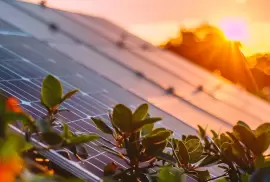
Understanding the Different Types of Solar Energy Systems
Is your home or business struggling with high energy costs? Understanding the different types of solar energy systems can provide a solution. This article will explore how systems like mass solar, polycrystalline silicon, and gallium contribute to reducing greenhouse gas emissions. Readers will discover the benefits of each system, enabling them to make informed decisions for their energy needs. By addressing these options, SunWave Energy aims to simplify the transition to solar, helping to alleviate the burden of rising energy prices.
Key Takeaways
- solar energy includes various systems like photovoltaic, thermal, and hybrid technologies for diverse applications
- energy storage solutions enhance efficiency and reliability in solar systems, ensuring consistent power delivery
- passive solar design optimizes natural sunlight, reducing dependence on mechanical heating and cooling systems
- community solar initiatives expand access to solar power by allowing shared investment in solar arrays
- advancements in solar technology contribute to increased energy independence and sustainability through innovative designs
What Is Solar Energy?
Solar energy encompasses various methods for harnessing the sun’s power, primarily through photovoltaic solar energy, which utilizes solar cells to convert sunlight into electricity. Thermal solar energy captures heat for immediate use, while passive solar energy focuses on the design of buildings to optimize natural sunlight and ventilation. Hybrid solar energy systems combine different technologies for enhanced efficiency and resilience, especially useful in mitigating risks posed by factors like wildfire. Additionally, sunwave energy integrates with these systems to further enhance sustainable power solutions.
Term:
Photovoltaic Solar Energy
Photovoltaic solar energy involves the use of photovoltaic power stations that convert sunlight directly into electricity using solar cells. This technology not only supports energy production but also enhances building insulation, contributing to overall energy efficiency. By integrating hybrid power systems and utilizing solar air conditioning, users can significantly reduce their reliance on traditional energy sources, leading to cost savings and a smaller carbon footprint.
Thermal Solar Energy
Thermal solar energy systems harness the sun’s heat to provide efficient energy solutions for heating purposes. These systems can significantly improve a building’s energy efficiency, offering a strong return on investment by reducing reliance on traditional electric generators. Technologies such as compact linear Fresnel reflectors enhance the overall performance of thermal systems, making them a viable option for reducing energy costs while capitalizing on extensive research in solar efficiency.
Passive Solar Energy
Passive solar energy leverages architectural design to optimize the use of sunlight for heating and cooling without the need for mechanical systems. This method often includes elements such as thermal energy storage, which captures solar heat during the day to moderate temperatures in buildings at night, helping to reduce dependence on external air conditioning. According to the International Energy Agency, integrating passive solar techniques with bioenergy systems can create a robust reservoir of sustainable energy solutions, ultimately leading to enhanced energy efficiency and lower utility costs.
Hybrid Solar Energy
Hybrid solar energy systems combine various power generation technologies to create a more reliable and efficient energy solution. By integrating solar panels with other methods, such as tidal barrage and waste-to-energy systems, these systems can enhance overall performance and resilience. This approach not only supports electrification but also promotes the effective use of metal components for increased durability, making hybrid systems a valuable choice for diverse energy needs.
- Photovoltaic Solar Energy
- Thermal Solar Energy
- Passive Solar Energy
- Hybrid Solar Energy
Solar energy shines brightly in our modern world. Now, let’s look at the different types of solar energy systems that harness this power.
What Are the Different Types of Solar Energy Systems?
What Are the Different Types of Solar Energy Systems?
Various solar energy systems cater to different needs and preferences. Grid-tied solar energy systems connect to the local power grid, allowing users to benefit from net metering. Off-grid solar energy systems operate independently, ideal for remote areas. Hybrid solar energy systems combine multiple technologies, enhancing reliability. Community solar energy systems allow groups to share resources, making solar power accessible to everyone. Each type highlights practical aspects of solar technology, such as the use of copper indium gallium selenide in photovoltaic panels or the integration of geothermal energy for efficient heating solutions.
Grid-Tied Solar Energy Systems
Grid-tied solar energy systems connect directly to the local power grid, allowing users to seamlessly transmit excess electrical energy back to the utility provider. Utilizing high-efficiency silicon solar panels, these systems facilitate energy transformation, effectively converting sunlight into usable electricity. By aligning with the goals of the Paris Agreement, grid-tied systems contribute to sustainable construction practices and play a vital role in reducing carbon footprints, benefiting both individual users and the environment at large.
Off-Grid Solar Energy Systems
Off-grid solar energy systems operate independently from the local power grid, making them an excellent option for locations where grid access is limited or non-existent. These systems often utilize advanced solar technologies such as single crystal panels and cadmium telluride, which maximize energy efficiency and support sustainable development initiatives. By producing clean electricity, off-grid systems contribute to reducing greenhouse gas emissions, and their performance can be enhanced by considering factors like local wind speed and environmental conditions to ensure reliable energy generation.
Hybrid Solar Energy Systems
Hybrid solar energy systems effectively integrate multiple energy resources, including sunlight and offshore wind power, to enhance energy reliability and efficiency. These systems often utilize innovative materials, such as indium in advanced photovoltaic panels, to maximize energy conversion. By combining diverse energy sources, hybrid systems help mitigate the impact of environmental factors like hail, ensuring consistent energy production even in challenging conditions.
Community Solar Energy Systems
Community solar energy systems provide an innovative solution for individuals who want access to solar power without having to install solar panels on their properties. These systems allow multiple participants to invest in a shared solar array, which generates electric current that is distributed among the contributors based on their share. Utilizing advanced technologies like crystalline silicon in their photovoltaic panels, community solar programs can reduce overall energy costs while promoting sustainability, making them an attractive option for those looking to benefit from clean energy without significant upfront prices.
Each system has its strengths and weaknesses. Understanding how they perform is key to making the right choice.
Evaluating the Performance of Solar Energy Systems
Evaluating the Performance of Solar Energy Systems
Key performance indicators (KPIs) are essential for assessing the effectiveness of solar energy systems, from photovoltaics to thermal solutions. Maintenance considerations vary between systems and are crucial for maintaining efficiency. Additionally, climate conditions significantly influence energy production, emphasizing the importance of materials like tellurium in manufacturing and the role of policy in supporting sustainable practices.
Key Performance Indicators for Solar Energy Systems
Key performance indicators (KPIs) for solar energy systems play a vital role in assessing their effectiveness and overall efficiency. These indicators often include metrics such as the energy output compared to fossil fuels like petroleum, system degradation over time, and the contribution of additional renewables like wind power. By monitoring these KPIs, stakeholders can gain insight into factors such as maintenance needs and performance under various conditions, including the impact of local deforestation and weather changes on output.
Maintenance Considerations for Different Systems
Maintenance considerations vary significantly among different types of solar energy systems, impacting their efficiency and longevity. For instance, passive solar building design relies heavily on the strategic placement of windows and insulation, minimizing the need for mechanical systems, while thermal systems may require regular checks on tanks that store heat. In regions like the Middle East, where cadmium telluride panels are prevalent, monitoring for environmental wear and performance degradation is essential to maximize energy output and ensure sustainability.
How Climate Impacts Solar Energy Systems
Climate has a significant influence on the performance of solar energy systems, affecting energy output and efficiency. For example, areas with consistent sunshine can maximize solar panel performance, while regions prone to heavy wood smoke or natural debris might experience reduced efficiency. Additionally, knowledge of energy conservation practices can guide users in optimizing their systems, while understanding potential tax credits can provide financial benefits for renewable energy investments, including solar and emerging sources like tidal power or technologies using molten salt for thermal storage.
As performance metrics reveal the strengths of solar energy systems, their real impact on wallets becomes clear. Understanding the economic benefits is vital for anyone considering the switch to clean energy.
The Economic Impact of Choosing Solar Energy Systems
The economic impact of choosing solar energy systems involves several critical aspects, such as the initial costs associated with various solar technologies, the long-term return on investment, and available incentives. Understanding these elements is vital for assessing how solar options, including systems utilizing selenium, can minimize the carbon footprint while enhancing ecology. Additionally, exploring tariff benefits and comparing solar configurations with alternatives like wind farms provide valuable insights into making informed energy decisions.
Initial Costs of Different Solar Energy Systems
The initial costs of different solar energy systems vary significantly based on the technology employed and the specific needs of the installation. For example, photovoltaic systems typically require a higher upfront investment compared to thermal systems, but they benefit from economies of scale as more users adopt the technology. Additionally, considering options like community solar can help mitigate these costs, aligning with sustainable development goals while reducing dependence on traditional energy sources like oil and enhancing utility energy efficiency.
Long-Term Return on Investment for Solar Technologies
The long-term return on investment for solar technologies is increasingly favorable as consumers seek energy independence and sustainability through renewable solutions. Technologies such as heterojunction solar cells represent advancements in efficiency, allowing users to generate more energy with less investment. By capitalizing on these innovations and reducing reliance on traditional energy sources, individuals can enhance their energy savings while contributing to environmental conservation, fostering a fluid transition to renewable energy systems.
- Energy Independence through Solar Technologies
- Advancements in Heterojunction Solar Cells
- Increased Efficiency and Sustainability
- Long-Term Savings and Environmental Impact
Incentives for Selecting Solar Energy Systems
Incentives for selecting solar energy systems play a significant role in encouraging adoption among consumers and businesses. Programs like net metering allow users to receive credits for surplus electric power generated, making solar installations financially appealing. Organizations such as the International Renewable Energy Agency emphasize the ecological advantages of solar energy, including benefits to biodiversity, as solar farms can coexist with various flora and fauna, providing sustainable energy solutions while preserving natural habitats, such as ponds and wetlands.
The choices made today will shape the energy landscape of tomorrow. As innovations emerge, they promise to redefine how we harness the sun’s power.
Future Trends in Solar Energy Systems
Emerging technologies in solar energy, such as floating solar and advanced solar cells, are transforming the landscape of efficient energy use. The integration of energy storage solutions is becoming essential for maximizing the potential of these systems. Innovations in design and materials aim to enhance solar efficiency, offering valuable insights into the future of community solar and its role in reducing reliance on fossil fuel power stations.
Emerging Technologies in Solar Energy
Emerging technologies in solar energy are reshaping how potential energy is captured and utilized, with innovations focusing on integrating kinetic energy and solar thermal energy into building architecture. These advancements aim to create structures that not only generate electricity but also optimize energy efficiency, contributing to a future where net zero emissions are achievable. For instance, some designs now incorporate flexible solar panels that adapt to different surfaces, enhancing aesthetics while maximizing energy production:
- Integration of kinetic energy in solar solutions
- Innovations in solar thermal energy systems
- Adaptive architecture for energy efficiency
- Contributions to achieving net zero emissions
The Role of Energy Storage in Solar Systems
Energy storage plays a crucial role in improving the efficiency and reliability of solar systems. By incorporating energy storage solutions, such as batteries, users can capture and store excess energy generated during periods of high solar irradiance, enabling them to use that energy even when sunlight is not available. This capability not only enhances energy independence but also allows for better management of energy resources, ensuring consistent power delivery and minimizing reliance on traditional energy sources like biofuel.
Implementing these technologies can enhance warranties as manufacturers increasingly recognize the value of integrated energy storage in advancing solar systems:
Innovations Driving Solar Efficiency
Innovations in solar energy technology are significantly enhancing efficiency and performance across various systems. For instance, hybrid solutions that combine cadmium telluride photovoltaics with advanced battery storage are improving energy consumption patterns, allowing users to maximize their roof space while maintaining a steady energy supply. This integration not only reduces the risk associated with fluctuating energy demands but also fosters a greater reliance on renewable resources, ultimately contributing to sustainable energy practices.
The promise of solar energy goes beyond predictions. In real life, these systems are changing homes and businesses across the country.
Real-Life Applications of Solar Energy Systems
Solar energy systems find practical applications across various sectors, showcasing their adaptability and efficiency. Residential use cases highlight the benefits of utilizing the photoelectric effect to power homes, while commercial deployments demonstrate the significant infrastructure enhancements possible with solar technologies. Additionally, utility-scale solar energy systems serve as a pivotal alternative to fossil fuel sources, often incorporating biomass for added sustainability, as reported by Energysage. Each section will further explore these applications, illustrating their relevance and effectiveness in addressing today’s energy challenges.
Residential Use Cases of Solar Energy Systems
Residential use cases of solar energy systems offer homeowners an effective way to harness renewable energy and reduce reliance on traditional sources like natural gas. Many households have adopted photovoltaic panels, which convert sunlight into electricity, thus generating clean energy that not only powers the home but also contributes to sustainability. Innovations in the use of plastics for solar technology simplify installation and enhance the durability of solar components, making it easier for families to embrace advancements that reduce their carbon footprint and take advantage of cost savings associated with utilizing wind and solar resources.
Commercial Deployments of Solar Technologies
Commercial deployments of solar technologies significantly contribute to reducing carbon emissions and improving energy efficiency. Many businesses are investing in solar power stations, utilizing thermal mass to store energy and offset operational costs. For instance, agricultural enterprises are integrating solar solutions to power irrigation systems, achieving greater sustainability while benefiting from the nameplate capacity of larger solar panels:
- Utilizing thermal mass for energy storage
- Reducing carbon emissions in commercial spaces
- Enhancing irrigation systems in crop production
- Maximizing nameplate capacity with larger installations
Utility-Scale Solar Energy Systems
Utility-scale solar energy systems play a significant role in electric power distribution by generating large amounts of electricity that can be fed into the grid. These systems utilize solar panels to capture photons from sunlight, converting them into usable energy. Moreover, integrating energy storage solutions with these systems enhances reliability, allowing for the management of energy output even during periods of low sunlight. Additionally, utility-scale projects can support initiatives such as desalination, promoting sustainable water solutions while reducing the overall carbon footprint associated with traditional energy production methods.
Conclusion
Understanding the different types of solar energy systems is essential for making informed energy decisions. Each system, whether grid-tied, off-grid, hybrid, or community solar, offers unique advantages tailored to specific needs and locations. By recognizing these options, individuals and businesses can effectively reduce costs, enhance energy independence, and support sustainable practices. Ultimately, embracing the right solar solution contributes significantly to a cleaner environment and a more resilient energy future.




